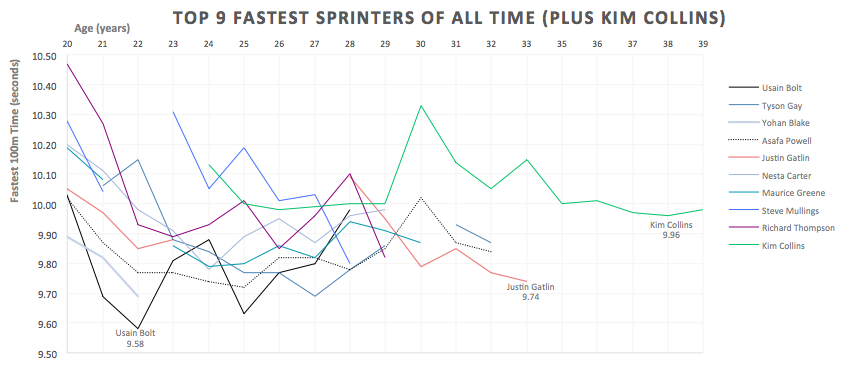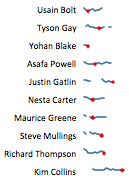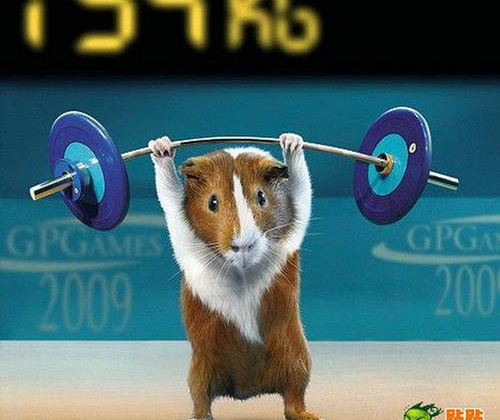The Late Career Peak of Justin Gatlin, who is not a mouse.
Justin Gatlin is one of the fastest humans of all time. He was one of the fastest men ever at 24 when he tied the then 100m World Record at 9.77 in 2004 only to see it struck off retrospectively due to a four year ban for doping. Now he’s even quicker, running 9.74 for the 100m and 20.57 for the 200m within weeks of each other. At thirty-three years of age.
The combination of age, performance and the fact that he’s faster than ever at this 33 makes Gatlin an extremely unusual case.
Extremely.
Unusual.
Indeed.
This week’s Irish Times column is on the work of Mr. Gatlin and the way his career development looks compared to the other fastest men of all time. Kim Collins is another extreme outlier, running in and around the 10 second mark for the 100m for many years longer than anybody else. The difference between Collins and Gatlin is that only one of them is realistically eyeing up a gold medal in the World Championships.
David Epstein, author of the Sports Gene and one of the key people involved in the investigation of athletics coach Alberto Salazar by ProPublica and BBC’s Panorama, offered some comment. I chatted with Ross Tucker, who wrote extensively on Gatlin back in May after his 9.74 run. I recommend reading it. Roger Pielke Jr read Tucker’s piece and graphed some top sprinters by age do see how their marks developed over time. The shape of Gatlin’s development is so very different from others.
So I recreated Roger’s work, scraping data from the IAAF website to generate the best times run by year for each of the nine fastest men of all time along with Kim Collins.

Not the clearest graph ever, I admit. But you get the picture.
Most have a relatively early peak then drift upwards (i.e. they get a bit slower) for the rest of their career. They might dip down a bit, but will merely re-approach their best times rather than setting PBs late in (sprinting) life. Collins looks different. Gatlin looks different. Richard Thompson set a PB at 29 (will he drift back upwards?). And Steve Mullings was trending downwards before he was banned for life in 2011 at age 28.

Sprinting Sparklines. Red Dot = PB
It’s not impossible that Gatlin is part of a new generation that’s shifting their peak into their thirties rather than their twenties. Or perhaps his training age, as opposed to chronological age, is more like 29 than 33 due to the time he spent away from competitive action. Equally, it’s not impossible that he’s more motivated than any of his competitors (whether this might make a tangible difference is another story).
But the elephant in the room is his drug history, and the unknown of how long the effects of performance enhancing drugs have a beneficial impact on the doper.
This great unknown is perhaps becoming less so. Studies in mice have shown the animals to retain benefits of performance enhancing drugs after the usage ceased. And it’s not just small, furry creatures. Swedish researchers have looked at powerlifters long removed from drug use whose muscles have essentially retained the greater capacity opened up to them by the use of that artificial aid.
And so, to this week’s Irish Times column:
The fastest man in both 2014 and 2015 over 100m and 200m is not a mouse. Were a mouse to crouch obediently on a miniature starting block and speed off down the track finishing with a neat dip across the line, it would be somewhat unusual. What Justin Gatlin has been doing at his advanced age of 33 is, like a mouse in lycra, somewhat odd.
After running a personal best 9.74 for the 100m in Doha in May, Gatlin ran 19.57 for 200m in Oregon last Sunday to win the US trials. Both times make him the joint fifth fastest man to ever run that distance. And all at 33, an age where most sprinters are firmly on the downswing.
On the track, determining peak performance is straightforward. The stopwatch tells all. Power and explosion track events have typically featured a peak in the mid to late twenties. There currently exist two clear exceptions to this: Kim Collins, who ran a personal best 9.96 100m last summer at 38, and Gatlin.
Credit to tt.mob.com for the weightlifting furry animal picture

